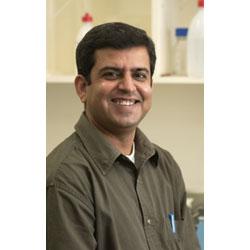CQU graduate to join team linking to overseas synchrotron light source facilities
Published on 14 July, 2004
Central Queensland University PhD graduate Dr Naveen Bhatia will soon join the team that assists Australian researchers to access synchrotron light source facilities in the United States and Japan.
Dr Bhatia is so excited about his posting that he is considering turning down the offer of another prestigious postdoctoral fellowship in Japan.
A synchrotron is a powerful micro-analytical technique which allows matter to be observed at the ‘atomic-scale’. It accelerates electrons almost to the speed of light and focuses the resultant bright light towards a very small area within the sample. Further, a complex computer analysis provides the sample’s molecular structure based on the image and information gathered by the machine’s detector.
 Dr Bhatia is one of the only six applicants selected for a highly-competitive and prestigious Australian Synchrotron Research Program (ASRP) Fellowship. His research proposal was backed by CQU researchers Professor David Midmore and Associate Professor Kerry Walsh, and Professor Alan Baker (The University of Melbourne).
Dr Bhatia is one of the only six applicants selected for a highly-competitive and prestigious Australian Synchrotron Research Program (ASRP) Fellowship. His research proposal was backed by CQU researchers Professor David Midmore and Associate Professor Kerry Walsh, and Professor Alan Baker (The University of Melbourne).
He will be a part of an ASRP team that enables Australian researchers to access the Advanced Photon Source at the Argonne National Laboratory in Chicago, USA, and the Australian National Beamline Facility (ANBF) at the Photon Factory in Tsukuba Science City, Japan.
Australia’s own world-class Synchrotron Facility, being built close to Monash University (Melbourne), is expected to be ready by 2007. It is expected that following completion of this Fellowship, Dr Bhatia will be one of the key players in the development of synchrotron research in Australia.
The ASRP Fellowship will allow Dr Bhatia to use state-of-the-art synchrotron-based micro-analytical techniques to provide insight on how certain plants are able to tolerate (and accumulate) extremely high concentrations of heavy metals in their tissues.
He said he would focus his research to elucidate how these ‘metal-hungry’ plants are able to cope and detoxify heavy metals within their tissues.His proposed research has potential that can lead to the development of designer crops to grow on metal-enriched soils, supplement dietary deficiencies, decontaminate industrial pollution (phytoremediation), or even harvest metals from low-grade mineral ores (phytomining).
“There are very few synchrotron set-ups in the world and this technology has found its use in plant science as well,” he said.
“It’s going to be a lifetime opportunity for me to be able to use such a fascinating technique.”.
Although based at the Australian Nuclear Science and Technology Organisation (ANSTO) in Sydney, Dr Bhatia plans to continue to work closely with CQU researchers, especially in the Plant Sciences, and with Professor Alan Baker of the University of Melbourne.

